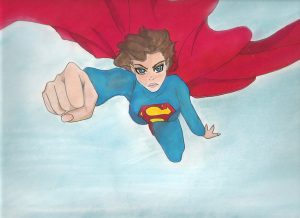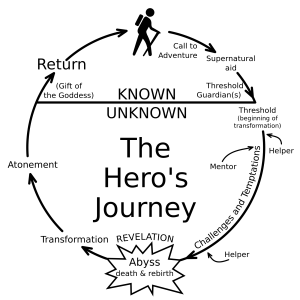Billions of individual stories have brought us here.
There must surely be a pattern, a common thread that ties all of humanity together.
If we could unlock an implicate order or system for living, it would show us a method to understand our lives better. Was Kierkegaard mistaken when he posited, “Life must be lived forwards but can only be understood backwards?”
A pattern language exists in all human systems. In all human history there is something we are learning about ourselves, beginning with a quest. Within every story ever told is the oldest story known to humankind and embedded in our collective memory—the story of a hero.
In the maturation process from child to adult and beyond, we all encounter and have to face a variety of personal challenges where we are tested, often severely so. What builds character and defines our destiny, is the ability to conquer our personal fears and doubts and face head-on our challenges. If we can overcome these challenges (nullify the giant or demon in the process), then we will be liberated from these dark forces, and advance with the lessons learnt and our power restored.
The purpose of life is within life itself—to live, to be inside the process.
Our suffering often points to that which is not working for us. For growth to occur, we must learn lessons and learn to accept what we cannot change whilst taking proactive action on the things we can change. It is not some mystery hidden away in an ancient script.
Until our self-realisations are living and breathing in actions, we are not finished.
As souls, we are here to learn. This is our school and training ground. Each ideology is like another school. Specific dynamics (like being born male or female, rich or poor, country of origin, religion and race) carry different opportunities for learning.
As we learn lessons from our life experiences, so our capacity for compassion and wisdom grows.
All recorded history and our oral traditions before that reflect our journey to survive, develop and achieve mastery of our environment. Swiss psychoanalyst, Carl G. Jung wrote about the “archetypes”—characters that recur in dreams of all people and in the myths of all cultures. Jung believed that archetypes were part of a deeper source of knowledge and mythology forming part of the “collective unconscious” of our intrinsic human mind.
The inner realm is the collective mind of all humanity—it binds us all together in a shared experience. Each person experiences a range of personalities that play out in the unfolding drama of life. This is the story of the soul.
In the European divination cards called the Tarot, the 22 Major Arcana (greater secrets) cards depict the hero’s journey. American scholar, Joseph Campbell in his classic, “The Hero with a Thousand Faces,” one of the most influential books of the last century, set out to map the human condition and define a pattern of development by the hero. Campbell describes the story of the “hero,” common to myth, ritual, drama and storytelling, reflecting our individual and collective psychological development.
The archetypal hero goes out on an adventure of discovery for his own personal growth and redemption, as well as representing something from his tribe or particular group. All of humankind is embodied in the hero’s journey—the story of our collective and individual origins.
Each time we evolve—especially during significant life phrases—we come back to repeat the story and re-experience its lessons.
Will Cather wrote:
“There are only two or three human stories, and they go on repeating themselves as fiercely as if they had never happened before.”
Campbell believed that all stories were essentially one and the same story told in unlimited variations and following the terms of the hero myth or “mono-myth” he laid out. The universal myth is universal, common to all cultures, to all people.
Campbell uncovered a pattern that lies within every story ever told.
Each person’s personal developmental process follows the hero’s journey, and in this way, we are all heroes of our own lives. Self-mastery requires that we journey to sometimes uncomfortable places, find and clear the debris (slay the dragon) come back renewed and inspired for our next journey. Each time we depart our homes (our comfort zone), we enter a field of unlimited possibility for growth and redemption.
In Maslow’s hierarchy of needs, self-actualisation is placed on the highest rung after the achievement of all basic needs. What is common to human development and the evolving human spirit, is to face challenges or obstacles along our path—and then to overcome them.
This make us all heroes. It reminds us why we are here and what we are here to do.
In mystical terms, a person undergoes catharsis to come out of the dark night of the soul, the negative forces inhibiting him from self-expression and individual expansion. The gateway to personal growth (movement) is to overcome personal barriers (limitations) to achieve goals. To overcome the force-field of inertia is key.
Achieving freedom is a path of liberation—one must first face and conquer one’s inner demons before one can truly “find oneself.”
When we face all our shadows, with every victory, a new cycle begins.
The universal power of the hero myth is revealed to us in our collective dreams. We recognise these heroes facing dark antagonists because the story is part of our intellectual model and cultural psychology. We see ourselves reflected back at us in these myths and legends. Even if the hero plays out an impossible and unrealistic scenario, we still resonate with our hero and see ourselves in his plight.
Emotionally, we still powerfully connect to our hero’s battle because it links us together—it forms part of our collective memory as human beings.
It also answers key existential questions of our origins:
Who am I and where do I come from?
What happens to the dead?
Am I alone?
What is good and evil?What is my purpose?
What happened in the past before I was born, and how did it make the present – how will the present affect the future?
Is there hope?
We are all unique story-tellers of our own lives who weave a tapestry of possibility via our imagination and connection to the collective unconscious. Each story-teller adjusts the myth to suit his own aspirations.
Hence, the hero has a “thousand faces.”
Stages of the The Hero’s Journey (Adapted):
1. Meeting the mundane, ordinary world.
2. Suffering descent, humiliation, separation or loss.
3. New hope: the call for adventure or change.
3. Fear of the unknown.
4. Meeting with the mentor.
5. First initiation: leaving the ordinary world and crossing the first threshold. (Now committed to journey)
6. Discovering the keys to success—facing tests, meeting enemies and finding allies.
7. The hero prepares for the final battle.
8. Confronting death or greatest fear.
9. Public victory—finding the treasure.
9. The road back home.
10. Private victory and integration—healing the wounded masculine and feminine and resolution of conflicting polarities.
11. Returning home victorious with the elixir.
_______________________________________________________________
Photo Credits: 1. WikiCommons (Wiki Media) 2. DeviantArt
No Copyright Infringement Intended.
What do you think? Feel free to comment down below!
You are awesome as you are, and I love you!
And if you love me back, please click ‘share’ up at the top!
David G Starlyte (ND) – Australia’s Leading Soul-Coach.
Find out more about me: http://transformationalmedicine.net
Facebook: davidstarlyte



